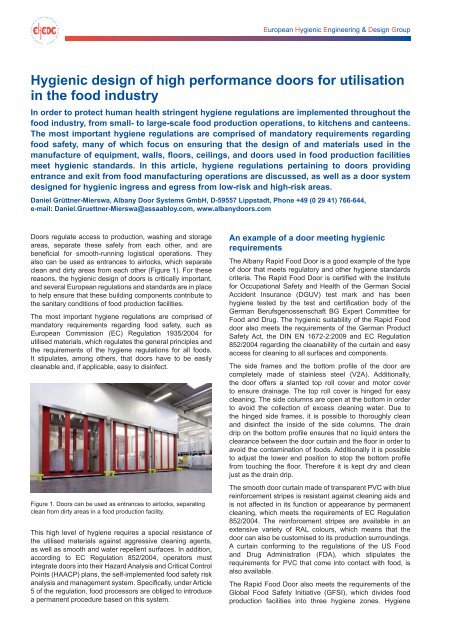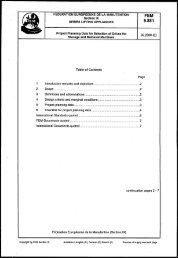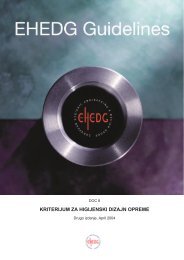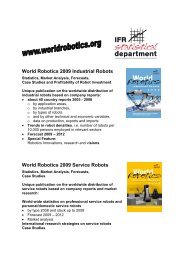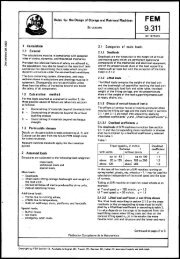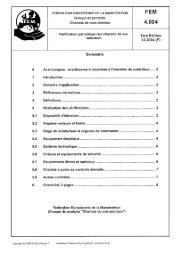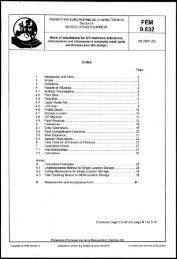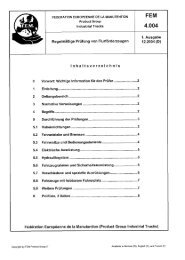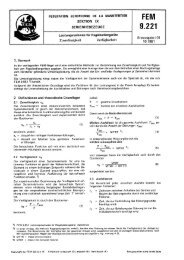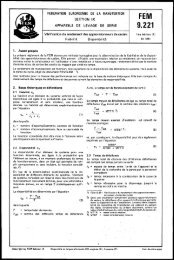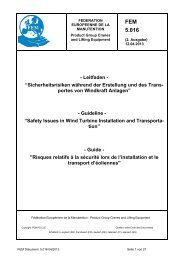to get a complimentary download version - (FKM), Verträge und ...
to get a complimentary download version - (FKM), Verträge und ...
to get a complimentary download version - (FKM), Verträge und ...
You also want an ePaper? Increase the reach of your titles
YUMPU automatically turns print PDFs into web optimized ePapers that Google loves.
European Hygienic Engineering & Design GroupHygienic design of high performance doors for utilisationin the food industryIn order <strong>to</strong> protect human health stringent hygiene regulations are implemented throughout thefood industry, from small- <strong>to</strong> large-scale food production operations, <strong>to</strong> kitchens and canteens.The most important hygiene regulations are comprised of manda<strong>to</strong>ry requirements regardingfood safety, many of which focus on ensuring that the design of and materials used in themanufacture of equipment, walls, oors, ceilings, and doors used in food production facilitiesmeet hygienic standards. In this article, hygiene regulations pertaining <strong>to</strong> doors providingentrance and exit from food manufacturing operations are discussed, as well as a door systemdesigned for hygienic ingress and egress from low-risk and high-risk areas.Daniel Grüttner-Mierswa, Albany Door Systems GmbH, D-59557 Lippstadt, Phone +49 (0 29 41) 766-644,e-mail: Daniel.Gruettner-Mierswa@assaabloy.com, www.albanydoors.comDoors regulate access <strong>to</strong> production, washing and s<strong>to</strong>rageareas, separate these safely from each other, and arebenecial for smooth-running logistical operations. Theyalso can be used as entrances <strong>to</strong> airlocks, which separateclean and dirty areas from each other (Figure 1). For thesereasons, the hygienic design of doors is critically important,and several European regulations and standards are in place<strong>to</strong> help ensure that these building components contribute <strong>to</strong>the sanitary conditions of food production facilities.The most important hygiene regulations are comprised ofmanda<strong>to</strong>ry requirements regarding food safety, such asEuropean Commission (EC) Regulation 1935/2004 forutilised materials, which regulates the general principles andthe requirements of the hygiene regulations for all foods.It stipulates, among others, that doors have <strong>to</strong> be easilycleanable and, if applicable, easy <strong>to</strong> disinfect.Figure 1. Doors can be used as entrances <strong>to</strong> airlocks, separatingclean from dirty areas in a food production facility.This high level of hygiene requires a special resistance ofthe utilised materials against aggressive cleaning agents,as well as smooth and water repellent surfaces. In addition,according <strong>to</strong> EC Regulation 852/2004, opera<strong>to</strong>rs mustintegrate doors in<strong>to</strong> their Hazard Analysis and Critical ControlPoints (HAACP) plans, the self-implemented food safety riskanalysis and management system. Specically, <strong>und</strong>er Article5 of the regulation, food processors are obliged <strong>to</strong> introducea permanent procedure based on this system.An example of a door meeting hygienicrequirementsThe Albany Rapid Food Door is a good example of the typeof door that meets regula<strong>to</strong>ry and other hygiene standardscriteria. The Rapid Food Door is certied with the Institutefor Occupational Safety and Health of the German SocialAccident Insurance (DGUV) test mark and has beenhygiene tested by the test and certication body of theGerman Berufsgenossenschaft BG Expert Committee forFood and Drug. The hygienic suitability of the Rapid Fooddoor also meets the requirements of the German ProductSafety Act, the DIN EN 1672-22009 and EC Regulation852/2004 regarding the cleanability of the curtain and easyaccess for cleaning <strong>to</strong> all surfaces and components.The side frames and the bot<strong>to</strong>m prole of the door arecompletely made of stainless steel (V2A). Additionally,the door offers a slanted <strong>to</strong>p roll cover and mo<strong>to</strong>r cover<strong>to</strong> ensure drainage. The <strong>to</strong>p roll cover is hinged for easycleaning. The side columns are open at the bot<strong>to</strong>m in order<strong>to</strong> avoid the collection of excess cleaning water. Due <strong>to</strong>the hinged side frames, it is possible <strong>to</strong> thoroughly cleanand disinfect the inside of the side columns. The draindrip on the bot<strong>to</strong>m prole ensures that no liquid enters theclearance between the door curtain and the oor in order <strong>to</strong>avoid the contamination of foods. Additionally it is possible<strong>to</strong> adjust the lower end position <strong>to</strong> s<strong>to</strong>p the bot<strong>to</strong>m prolefrom <strong>to</strong>uching the oor. Therefore it is kept dry and cleanjust as the drain drip.The smooth door curtain made of transparent PVC with bluereinforcement stripes is resistant against cleaning aids andis not affected in its function or appearance by permanentcleaning, which meets the requirements of EC Regulation852/2004. The reinforcement stripes are available in anextensive variety of RAL colours, which means that thedoor can also be cus<strong>to</strong>mised <strong>to</strong> its production surro<strong>und</strong>ings.A curtain conforming <strong>to</strong> the regulations of the US Foodand Drug Administration (FDA), which stipulates therequirements for PVC that come in<strong>to</strong> contact with food, isalso available.The Rapid Food Door also meets the requirements of theGlobal Food Safety Initiative (GFSI), which divides foodproduction facilities in<strong>to</strong> three hygiene zones. Hygiene


